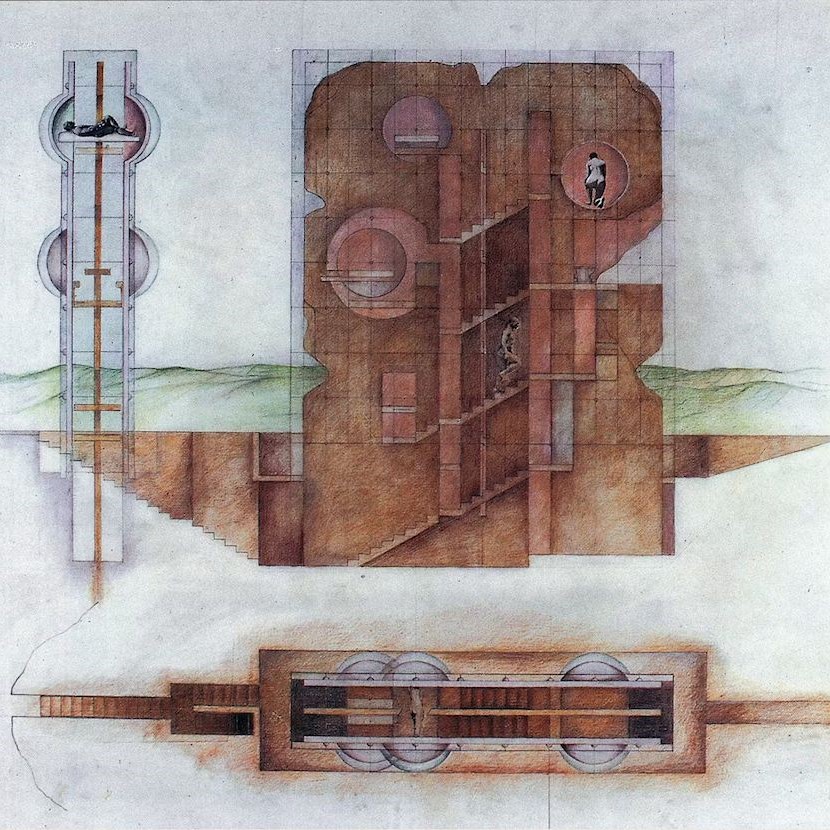Between 1971 and 1974, Austrian-American architect Raimund Abraham created one of the most intriguing unbuilt projects: “House Without Rooms.” Abraham’s work represents a fundamental shift in how we can think about architecture. Rather than designing buildings to be constructed, he explored architecture as a realm of ideas, using drawings to investigate concepts that don’t necessarily require physical verification.
Abraham was deeply influenced by the Viennese tradition of integrating architecture with sculpture and by philosophical ideas, particularly from figures like Ernst Mach. His drawings often delve into the subjectivity of spatial conditions and interiority, focusing on the human dwelling and its associated rituals. This approach positioned his work at the intersection of art, philosophy, and architecture.
On ‘House Without Rooms’, by Raimund Abraham
Raimund Abraham’s ‘House Without Rooms’ challenges our basic understanding of what a house should be, by eliminating the very thing we expect most from architecture—rooms and walls that divide the space.
Instead of organising space around practical functions, Abraham organised his conceptual house around what he called “archetypal stations”—symbolic places that represent universal human experiences of dwelling. These might include thresholds (places of arrival and departure), hearths (spaces of gathering and warmth), or windows (connections between inside and outside).
This approach draws on anthropological ideas about sacred and profane space. The house becomes a stage for the rituals of daily life rather than simply a container for furniture and activities.
The original artwork, created in 1974, is a mixed-media piece incorporating colored pencil, graphite, and cut-and-pasted printed paper on paper. It measures 34 5/8 × 38 1/8 inches (87.9 × 96.8 cm). ‘House Without Rooms’ has been showcased in several prominent exhibitions. These include “The Changing of the Avant-Garde: Visionary Architectural Drawings from the Howard Gilman Collection” (2002–2003) and “Endless House: Intersections of Art and Architecture” (2015–2016), both held at MoMA.




Abraham’s project arrived during a period when many architects were questioning modernism’s emphasis on pure functionality. While most architects responded by adding decorative elements or historical references, Abraham took a more radical approach—he questioned whether architecture needed to be built at all.
This perspective influenced a generation of architects to think more conceptually about their discipline. It suggested that architects could be researchers, philosophers, and poets, not just builders.
Abraham’s “House Without Rooms” remains relevant not because it solved any practical housing problems, but because it expanded our understanding of what architecture could be. By removing rooms, Abraham paradoxically created more space—conceptual space for thinking about dwelling, memory, and the meaning of home.
“House without Rooms” represents that power of architecture which lies not only in its ability to shelter bodies, but in its capacity to house ideas, dreams, and the intangible aspects of human experience. In Abraham’s own words: “I don’t ever need a building to verify my idea.” Sometimes, the most important architecture exists only in our imagination.
About the Series
The House as an Idea: Unbuilt Series
Some of architecture’s most influential houses were never built. These projects exist only as drawings and concepts, yet they fundamentally changed how we think about dwelling. Through this series, we present Raimund Abraham’s unbuilt ideas that explore how he used residential projects to test radical ideas about space, living, and human experience. Freed from construction constraints, these paper architectures became laboratories for architectural thinking, proving that sometimes the most important buildings exist only in our imagination.




